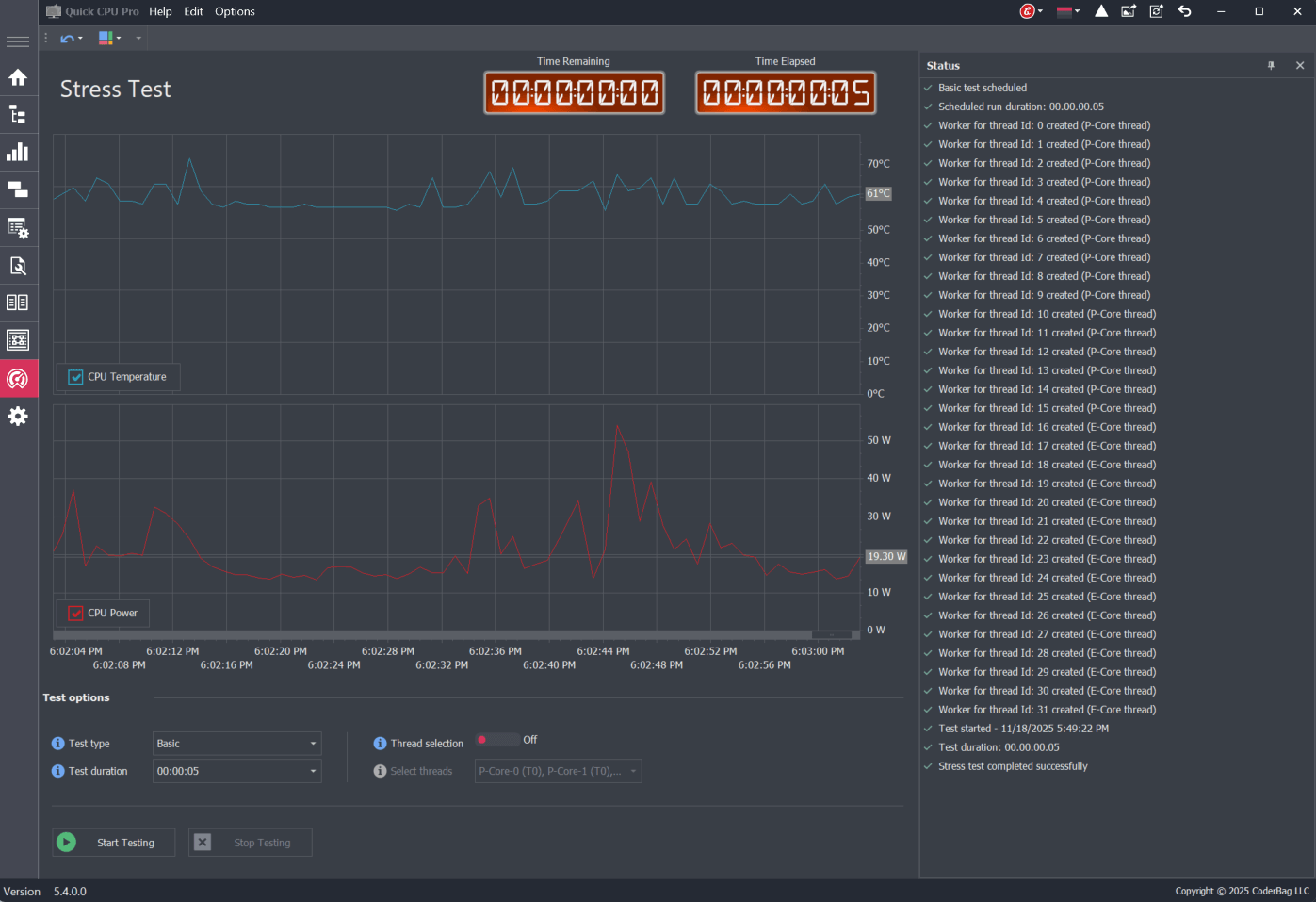CPU Stress Test
Workload Generation for Stability, Thermal and Power Evaluation
Table of Contents
CPU Stress Testing - Overview
The CPU Stress Test component in Quick CPU allows users to place their processor under a controlled, high-load environment to evaluate system stability, cooling efficiency, and performance behavior. This functionality is designed for testing thermal limits, validating overclocking or tuning adjustments, and ensuring reliable operation under sustained workloads.
All tests use Quick CPU’s optimized workloads that exercise different instruction sets (SSE2, AVX, AVX2, etc.) based on CPU capabilities.
What Does a CPU Stress Test Do?
A stress test applies a continuous, repeatable workload designed to push the CPU harder than typical real-world applications. This allows Quick CPU to help you:
- Evaluate overall system stability under sustained load
- Observe peak and long-term CPU temperatures
- Verify cooling performance (fans, thermal paste, radiator, airflow)
- Analyze power delivery
- Compare performance modes, power plans
All stress operations are temporary and revert once the test ends.
Main Screen Overview
The Stress Test view provides all controls needed to configure and monitor the workload. Each component updates in real time as the test runs.
| Element | Description |
|---|---|
| Test Type | Selects workload and CPU instruction set |
| Test Duration | Defines automatic stop time |
| Thread Selection Toggle | Allows targeting specific logical CPU threads |
| Thread Picker | Displays available core/threads when selection is enabled |
| Start / Stop | Begins or ends the stress test |
| Time Elapsed / Remaining | Live counters showing test progress |
| Status Panel | Reports lifecycle events, errors, and state changes |
| Temperature & Power Charts | Displays real time thermal and power telemetry |
Test Types Explained
Only tests supported by your processor’s instruction set architecture will appear. Each workload varies in intensity and power usage.
| Type | Description | Typical Use |
|---|---|---|
| Basic | General workload with moderate CPU utilization | Quick functional check or light heating test |
| SSE2 | Legacy vector instructions supported by all modern CPUs | Baseline compatibility and stability checks |
| AVX | Advanced Vector Extensions (AVX/AVX1) workload | Higher thermal output |
| AVX2 / AVX512F | More demanding vector math with strong heat generation | Thermal stress validation and power behavior analysis |
Test Duration
The Test Duration field defines how long the stress test will run before automatically stopping. This value is required and must be set before the test can start. The default value is 00:00:00:00, which indicates no duration and prevents the test from beginning until a valid time is entered.
Duration is entered or selected in the following format:
DD:HH:MM:SS — Days : Hours : Minutes : Seconds
- Minimum: 00:00:00:01 (1 second)
- Maximum: 30:00:00:00 (30 full days)
Once the test is running, Elapsed Time increases upward while Remaining Time counts down toward zero. When the timer expires, Quick CPU stops the workload automatically.
Suggested Usage Durations
- Quick temperature check: 2–5 minutes
- Thermal stabilization: 10–20 minutes
- Short stability verification: 30–60 minutes
- Extended endurance testing: several hours
- Long-term continuous burn in: up to multiple days (only if required)
While Quick CPU supports durations up to 30 days, typical users rarely need more than 30–120 minutes for meaningful evaluation.
Selecting CPU Threads (Optional)
By default, all logical CPU threads are included in the test. Thread selection allows deeper control for advanced analysis:
- Compare cores with different eficienty types on hybrid architectures
- Limit heat output by selecting fewer threads
- Run lightweight diagnostics on specific cores only
At least one thread must be selected for the test to start.
Starting a Test
- Open the Stress Test panel
- Select the desired Test Type
- Configure the Duration
- (Optional) Enable thread selection and choose specific cores/threads
- Click Start to begin the test
- Monitor live charts, temperatures, and status messages
- Click Stop at any time or wait for the timer to finish
Status Panel Messages
The status panel provides information about the test lifecycle:
- Start confirmation and scheduler status
- Workload type and duration summary
- User initiated or automatic stop notices
- Error messages
About Our Software
Enhance and monitor system performance, customize favorite settings and more…



